In today’s post we bring the Hollywood-Berta prototype. The most advanced car to compete in the Brazilian Divisão 4 and that dominated the category to the point of being accused (unfairly) of being responsible for its demise.
Oreste and Berta LR of the World Sportscar Championship
You can’t talk about Berta-Hollywood without first talking about Oreste Berta. The Argentine is a living legend of South American motorsport, having actively participated in several competitions in the region, from single-seaters to touring cars. Starting in 1966, he dedicated himself to the IKA factory team, and was a key player in the Turismo Carretera’s four championship wins and the moral victory of the Torino 380W coupes at the 84 Hours of Nurburgring in 1969.
After the Nurburgring race, the seed of what would be the “crown jewel” of Oreste Berta’s projects emerged: what was initially a plan to buy a prototype in order to have an Argentine team at the next 1,000 km of Buenos Aires soon changed radically after the great Fangio suggested to build an Argentine car, a plan readily supported by Patricio Peralta Ramos, then CEO of the newspaper La Razón. Berta then started to design a prototype for the World Cup of FIA Sport-Prototypes, with the development largely financed by the Argentine newspaper, hence the initials LR of the name of the prototype that debuted in the 1,000 km of Buenos Aires in 1970. To the astonishment of the competitors and the media, drivers Carlos Marincovich and Luis Rubén di Palma took third place. on the starting grid.

In the race, the Berta’s prototype faced some bad luck after a series of engine problems forced the team to withdraw the car with only 28 laps, mainly to save the equipment because the 200 Miles of Buenos Aires would be disputed the following week.

Again the performance in the qualy was excellent, with a second position only behind an Alfa T33/3. Such was the good impression generated in both events, that the team earned an invitation to compete in the 1,000 km of the Nurburgring. Unfortunately, the Berta LR did not present the same performance obtained in the Argentine races, with a distant 14th place on the starting grid, followed by a withdrawal during the sixth lap for not having adequate rain tires.

After the series of problems experienced in 1970, for the 1971 season Berta took on a double challenge: to develop a new engine, of its own manufacture to replace the problematic Cosworth V8 (despite being dominant in F1, the English engine proved to be unreliable and thirsty for endurance events) and, in parallel, to evolve the 1970’s design. The Berta’s main evolutions were a new chassis, in 4130 steel, and a new carbon fiber body. That year, the Buenos Aires 1,000 km would be the opening race of the World Championship of Makes, but many problems limited participation to the first day of free practice, with the Cosworth engine again lacking, followed by problems with the bodywork.

Thus, Oreste Berta turned his efforts in a race against time to complete the development of the new V8 engine, in addition to a new chassis and bodywork for the 1972 1,000 km of Buenos Aires. Much was said about the Berta V8 engine at the time, which would be more powerful and with greater elasticity in transient regimes compared to the Cosworth, but the Argentinian industrial park was not up to the technical needs of the project, and again the Berta LR did not even start after having ranked 24th in the qualy.

The car was supposed to compete again at the inauguration of the Autodromo Juan Manuel Fangio in Balcarce, where despite having ranked first among the cars made in Argentina, Oreste decided to withdraw from the race dissatisfied with the handling behaviour of the prototype.
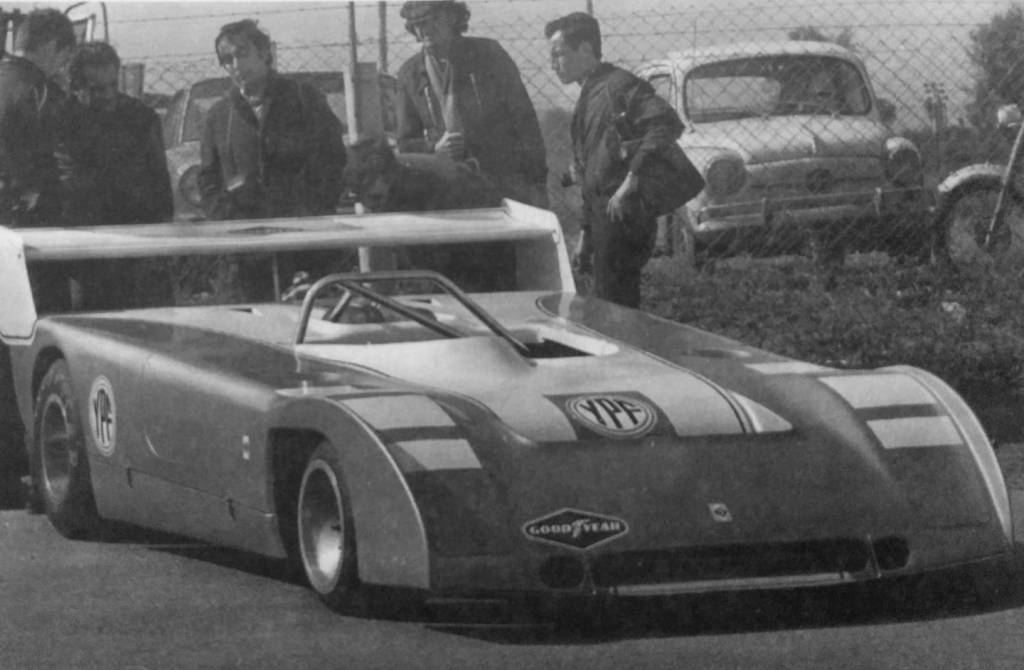
For 1973 Berta was preparing a new version of his prototype, but the financial support promised by the Argentine government did not materialize, putting the Argentine prototype sport project on hold.
Berta-Hollywood and The Divisão 4
Meanwhile, Brazil was going through a transitional phase, with the ban on imported cars competing in the Campeonato Brasileiro de Viaturas Esporte (Brazilian Sports Car Championship) from 1973. This made the Hollywood team’s Porsche 908/2 obsolete and worse, left driver Luis Pereira Bueno without a car to match his skill on the tracks. This is how the first conversations between Anísio Campos, Luis Pereira Bueno and Oreste Berta emerged, who already knew each other from the disputes between the Porsche Hollywood and the Berta-Tornados in the Sudam tournament.

Thus, came the idea of adapting the Berta LR to receive the engine from the Brazilian Ford Maverick. The initial tests were carried out at Autódromo Oscar Cabalén by Luis Pereira Bueno and, according to the plan released at the time, while the fine adjustments were carried out by Berta, the Hollywood team would start the Brazilian construction of a second chassis and bodywork identical to the Argentine ones, as determined by the CBA for Divisão 4 national prototypes. Subsequently, the Argentine car would be imported without an engine to Brazil as a “model”, serving as a donor for the other components.

Initially, the Berta-Hollywood’s debut was scheduled for the 1974 Cascavel de Ouro, but it only materialized in the opening stage of the 1975 Division 4 championship, held in Interlagos. At the start, Luis Pereira Bueno’s car had problems, dropping to last, but such was the advantage of the car that, at the end of the first lap, it had already recovered first position, establishing the new record of the category in Interlagos with the time of 2:51.67 (almost 9 seconds below the previous record held by Jan Balder of Avallone).

After this performance, Luis Pereira Bueno arrived as the favorite for the second stage, held in Tarumã, but he had to settle for a third place overall, and second in class B, after a flat tire on the first lap forced a pit stop. As a consolation, the overall victory went to Maurício Chulan’s Heve P6, also from the Hollywood team, and Luizinho once again broke the track record for national cars with a time of 1m06s57.

The third race of the season was played at the Brasília race track, in two heats. In a report to Quatro Rodas magazine, Luizinho gave some interesting information about the car, first stating that the Maverick engine produced 58 kgf.m of torque, which forced the driver to start in second gear to prevent the car from spinning it’s tires. Again, the duo set the track record for national cars, with a time of 2m00s70.

Another victory for the Berta/Luisinho team in the fourth stage, held in Goiânia, and a new record, this time the overall track record so far, with a time of 1m30s70.

In the fifth round, held in Cascavel, an accident between Berta de Pereira Bueno and the Bimotor prototype of Airton Szidlowski took the pilot from São Paulo out of the race, opening the way for Valdir Favarin from Paraná to open 2 points of advantage in the scoring table, arriving as the leader for the final round in Interlagos.
However, the Hollywood team needed only to win to guarantee the Class B championship and, with a car much faster than the competition, Luizinho opted for an ultra conservative pace to safeguard the result (so much so that his best lap in the race was 2:59.32, nearly 8 seconds above the best lap of the opening stage). In the end, Luis Pereira Bueno became champion of Class B of Division 4, in what would be the swan song of the category. After years of sitting at the Hollywood headquarters, the Berta Hollywood was acquired by an Argentine collector, and was recently restored by Oreste Berta himself in Alta Gracia.
Tech Analysis
Now let’s go to our traditional technical analysis, to know all the details of Hollywood-Berta.
Part 1 – Chassis
The Berta/Hollywood chassis is of tubular construction in 4130 steel weighing only 30 kg, a constructive concept that at the time was being replaced by aluminum monocoques, but continues to be used today in cars such as the P1 of Endurance Brasil.
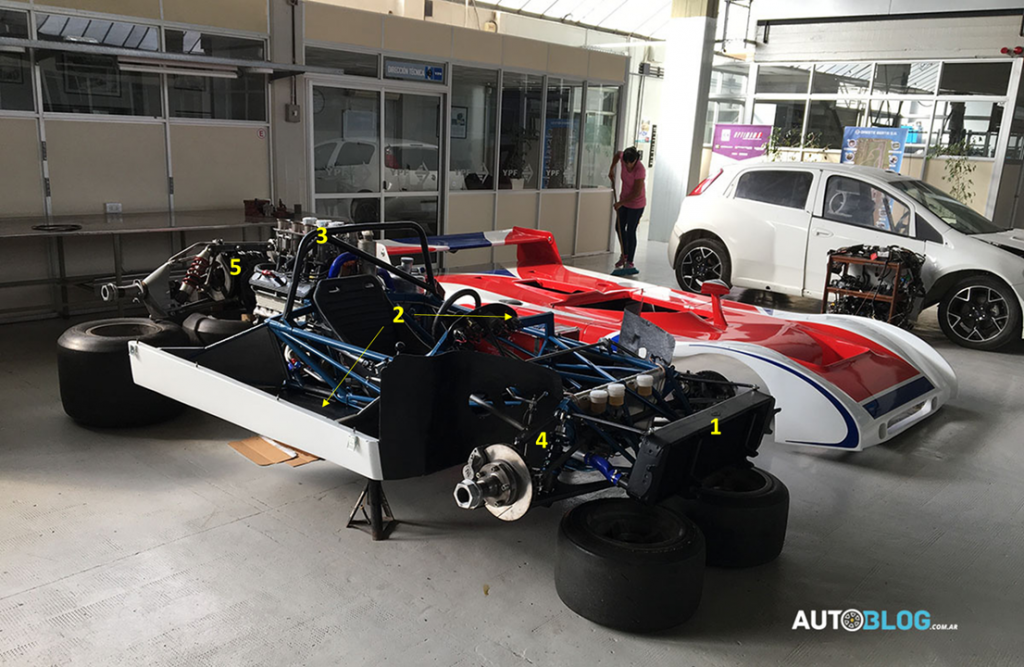
The layout is also typical of the time, with the radiator at the front (1) and the two fuel tanks, with 60 liters each, mounted on the side of the cockpit (2). It is also interesting to note how much security has evolved in these almost 50 years: even though the Berta/Hollywood was in line with the safety requirements of the time, we can see how the rollbar (3) is just a rectangle with a crossbar, much more fragile than the designs of 6 points currently required by the FIA. It is also notable how the top of the pilot’s head was above rollbar, a contrast to the much lower position that a pilot is in a similar modern prototype, as we can in the GeeBee R1 of the images below:



Part 2 – Powertrain
To move the prototype, the same Ford 302 V8 engine from the Divisão 3 Maverick-Berta was chosen, with Gurney heads, a command developed by Berta and four Weber 48-IDA carburetors and electronic ignition.

This specification was very similar to the engines of the Ford GT40 that won Le Mans in 1968 and 1969, developing 450 HP and 58 kgf.m of torque, respectable numbers until today. In addition, it had more than proven resistance after winning several long-duration races with the Maverick, and on the Berta prototype was mated to a Hewland DG300 transaxle.
Part 3 – Aerodynamics
We cannot expect a high level of aerodynamic refinement from Berta/Hollywood (by today’s standards), since in the 70s the search for downforce was still a relatively new field of race car development, which is not to say that the prototype did not use interesting solutions. Unlike the Berta LR, which used carbon fiber in parts of its fairing, the Berta Hollywood uses a fairing made of fiberglass and polyester resin.
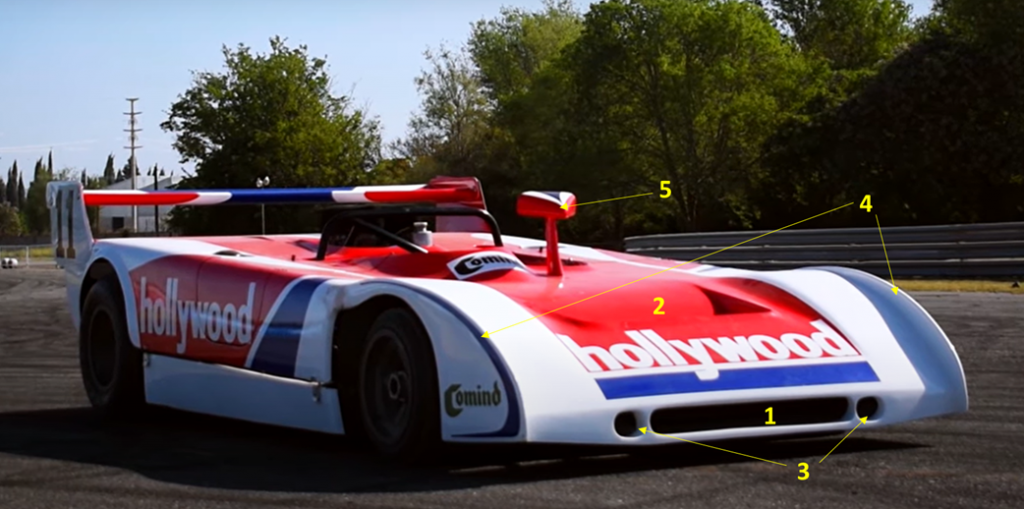
At the front, the Berta/Hollywood have the air intake for the radiator (1), which vents the pressure in an opening in front of the cockpit (2). This central inlet is surrounded by two circular inlets for cooling the front brakes (3).
Another characteristic typical of the time, used mainly in the McLaren Can-Am, are the fences (4), used to prevent the migration of air through the sides. This type of design is uncommon these days, but it can still be seen on the rear section of Brazilian prototype DTR01 and on the roof of Toyota’s GR010 Hypercar. Another typical feature of the 1970s is the single, centrally mounted rearview mirror (5).
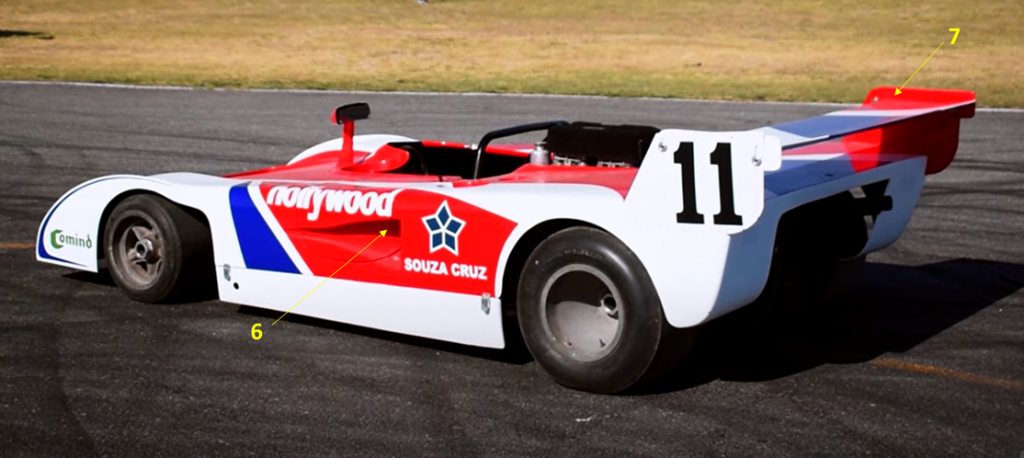
Going to the car’s profile, there is a large NACA duct (6) only on the left side of the prototype. The rear wing (7) is a single element with a long chord and side supports that are integrated to the bodywork.
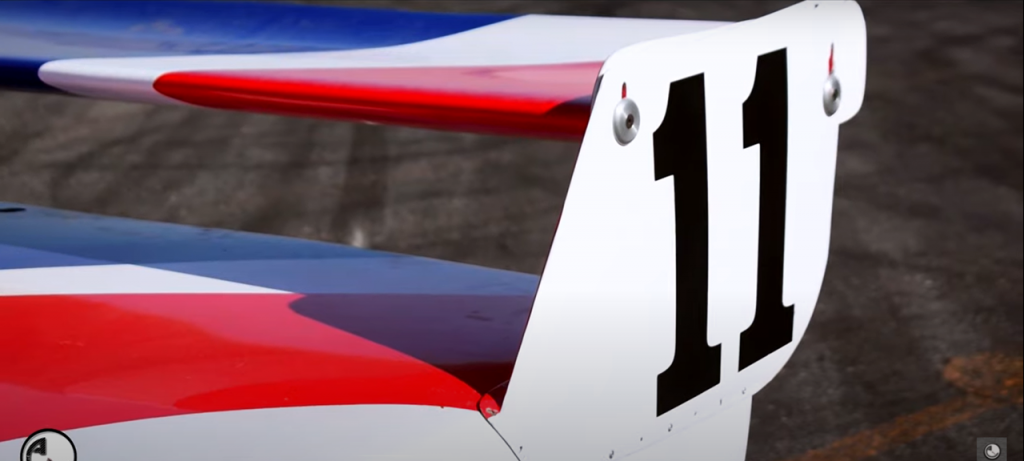
Such was Berta’s dominance in Division 4 that the model hardly needed any changes. Still, at least two aerodynamic elements were added, both in the front section: two canards (8) to increase the front downforce and a kind of flap (9) in the radiator ventilation opening, in this case possibly to improve the hot air extraction. and, consequently, engine cooling.

In addition, when racing in 1975 the Berta/Hollywood featured a small front splitter (10), absent in the post-restoration version.
Part 4 – Performance
Being a car so far ahead of its time, there has always been curiosity about how the Hollywood-Berta would perform compared to modern cars. To try to assess this question, we made a survey of Berta’s lap times in race tracks that suffered few changes in the layout in this period, and we compared it to prototypes of the 3 categories of Endurance Brasil:

Unfortunately, we don’t have enough data for a detailed comparison, but although it is not the ideal method, given there are a lot differences in asphalt condition, drivers and the evolution of tire compounds, it is interesting to perceive the performance gain after a technical advance of almost 50 years. Even with 30% less power, a P3 aspirated MRX today is 2 to 3 seconds faster than the Berta, a fact that is due to advances in dynamics such as tires, dampers and suspension geometry, in addition of course to the advance in the understanding of the operation and aerodynamic design.
Another example is the performance on the Goiânia track: the Hollywood-Berta reached around 260 km/h at the end of the main straight, comparable to what the AJR achieve today, but the total lap time is 13 seconds higher than the modern prototype, due to the same reasons as above. Even in relation to the GeeBee R1, a car about 45% heavier and with a “less modern” design, the performance difference is considerable.
I remind you that this comparison is not intended, in any way, to belittle the performance of Hollywood-Berta, only to demonstrate how much automotive technology has evolved in 50 years. So much so that times of 1m06s in Tarumã were the same as those obtained by the Porsche 908 of Team Z, and only came to be obtained by national prototypes around 2005, a testament to the efficiency of the Argentine project.
Results:

You may also be interested in:
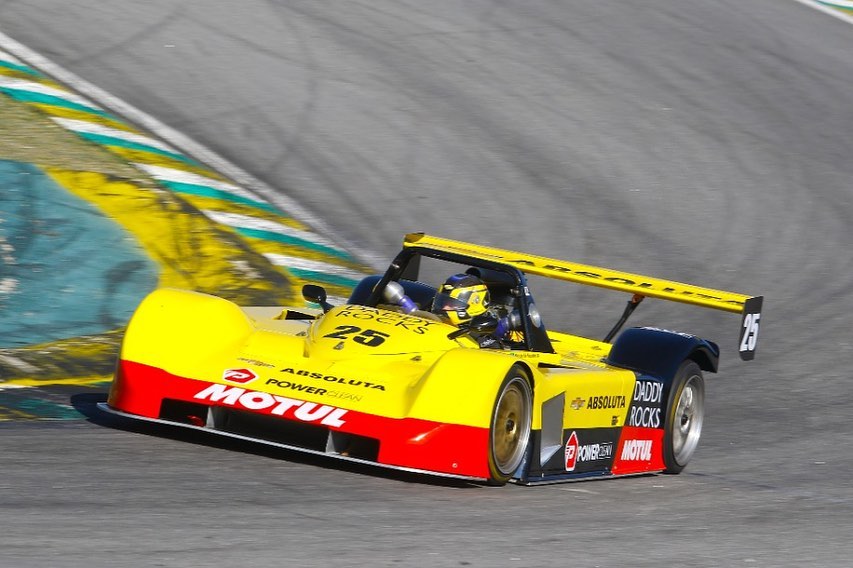
Absoluta ABS01 / Braspress Alfran 450A (2021 – )
The Absoluta ABS01 prototype is a project by João Alfran, and was originally built in 2005 for the Braspress team of Urubatan Helou. Now the project regained life at the hands of Ney Faustini, to compete in the competitive P2 category of Endurance Brasil.

GT Racecars DIMEP GT R1 / GeeBee R1 (2008 – 2019)
Developed at the turn of the 2000s, the GT R1 has a rich history, both on and off the track.
Sources:
Berta LR – La História (1ª Parte). Available at: http://www.porsche917.com.ar/bertalr/berta_01_hist01.htm
Berta LR – La História (2ª Parte). Available at: http://www.porsche917.com.ar/bertalr/berta_01_hist02.htm
Berta LR – La História (3ª Parte). Available at: http://www.porsche917.com.ar/bertalr/berta_01_hist03.htm
Berta LR – La História (4ª Parte). Available at: http://www.porsche917.com.ar/bertalr/berta_01_hist04.htm
Berta LR – La Técnica del Berta LR. Available at: http://www.porsche917.com.ar/bertalr/berta_03_tecnica.htm
Maverick Berta-Hollywood: Temporada de 1974. Available at: http://mavericknahistoria.blogspot.com/2019/01/maverick-berta-hollywood-temporada-de.html
Hollywood vê saldo ótimo. Available at: Jornal dos Sports 03/01/1974
Berta esporte é motivação para Luís Bueno. Available at: Jornal dos Sports 02/04/1974
Campeonato de construtores vê novo carro. Available at: Jornal dos Sports 23/04/1974
Hollywood lança carro nas finais. Available at: Jornal dos Sports 01/11/1974
Berta-Hollywood estréia. Available at: O Cruzeiro
O que há em Interlagos. Available at: A Tribuna, 30/11/1974
Berta/Hollywood na reta final. Available at: Correio Braziliense
Luis Bueno defende seu cartaz de tetra. Available at: Jornal dos Sports, 15/03/1975
Muffato: Destaque na Divisão quatro. Available at: Diário do Paraná, 25/03/1975
Pista Livre. Available at: Jornal dos Sports, 12/07/1975
Divisão 4. Available at: Folha de São Paulo, 06/07/1975
Brasília: O Berta de Luisinho vence fácil. Quatro Rodas, setembro de 1975.
Super-Vê e Divisão 4 em Goiânia. Quatro Rodas, novembro de 1975.
Pista Livre. Available at: Jornal dos Sports, 21/11/1975
A vitória de Luizinho, de Jaime, etc. Available at: Folha de São Paulo, 8/12/75
Divisão 4: Bueno e Chulan, os campeões. Available at: A Tribuna, 9/12/1975
Pista Livre. Available at: Jornal dos Sports, 7/12/1975
Oreste Berta inauguró su taller de restauración de autos clásicos (y Horacio Pagani ya encargó un LR V8). Motor1.com. Available at: https://ar.motor1.com/news/478725/oreste-berta-inauguro-su-taller-de-restauracion-de-autos-clasicos-y-horacio-pagani-es-su-primer-cliente/
BERTA LR V8 SPORT PROTOTIPO – HOLLYWOOD. Available at: A Toda Velocidad.
Oreste Berta restauró el LR Hollywood. Available at: https://ar.motor1.com/news/567999/oreste-berta-restauro-lr-holywood/.

